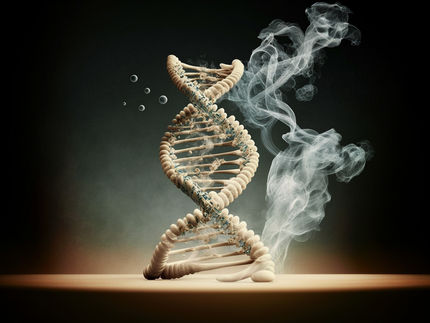New imaging technique shows how DNA is protected at chromosomes' ends
A new imaging technique has allowed researchers at North Carolina State University, the University of North Carolina at Chapel Hill, and the University of Pittsburgh to see how DNA loops around a protein that aids in the formation of a special structure in telomeres. The work provides new insights into the structure of telomeres and how they are maintained.
Telomeres are essentially caps on the ends of linear chromosomes, which are the structures inside our cells that contain DNA with our genetic information. In terms of function, telomeres are like the plastic coating (aglet) on the ends of shoelaces that prevents the laces from unraveling. In healthy cells, telomeres protect the chromosome by tucking away any overhanging ends of DNA strands to form a lasso-like structure known as a T-loop. Without telomeres, the cell's DNA repair proteins would read the overhanging ends as a break to be mended and attempt to either bind chromosomes together or send special proteins to digest them away.
Researchers know that a protein called telomeric repeat-binding factor 2 (TRF2) is key to telomeric structural integrity due to the role it plays in forming the T-loop. But researchers didn't know the mechanics behind the DNA compaction and T-loop formation by TRF2.
"TRF2 can compact DNA, which is important for T-loop formation," says NC State physicist Hong Wang, lead author of a paper describing the research. "But prior to this work, researchers did not know where the DNA was going or how TRF2 compacted it -- we could only see the DNA strand going into and out of TRF2 complexes, but couldn't see the DNA in the complexes. This is because we were using traditional atomic force microscopy (AFM) techniques, in which the protein-DNA shows up as a single blob, and the DNA path information is missing."
The breakthrough came with a new imaging technique, dual-resonance-frequency-enhanced electrostatic force microscopy (DREEM), which was developed by University of North Carolina at Chapel Hill chemist and co-author Dorothy Erie, former UNC and NC State postdoctoral researchers Dong Wu and Parminder Kaur, and was featured earlier this year in Molecular Cell. The technique utilizes the fact that DNA is negatively charged along its backbone. By applying DC and AC biases between the AFM probe and sample surface, DREEM can detect very weak electrostatic interaction differences when it scans over protein versus DNA regions. In this way, DREEM enables direct visualization of DNA wrapping outside histone proteins.
"DREEM allowed us to see the DNA's path through the TRF2 complex," says Wang. "Based on the DREEM images that we got, we now think there may be two orders of DNA compaction within the telomere - first, DNA wraps around a TRF2 protein in the interior of the complex. Then, multiple TRF2 molecules come together and create DNA loops that stick out from the TRF2 proteins.
"We think that this protruding loop provides the entering site for the telomere overhangs to tuck in to form the T-loop structure. This process ultimately helps to maintain the protective structure that prevents fusion of chromosomes or the slow erosion of telomere DNA. Our future work will try to determine if this is indeed the case."
Original publication
Most read news
Original publication
Other news from the department science

Get the life science industry in your inbox
By submitting this form you agree that LUMITOS AG will send you the newsletter(s) selected above by email. Your data will not be passed on to third parties. Your data will be stored and processed in accordance with our data protection regulations. LUMITOS may contact you by email for the purpose of advertising or market and opinion surveys. You can revoke your consent at any time without giving reasons to LUMITOS AG, Ernst-Augustin-Str. 2, 12489 Berlin, Germany or by e-mail at revoke@lumitos.com with effect for the future. In addition, each email contains a link to unsubscribe from the corresponding newsletter.
Most read news
More news from our other portals
Last viewed contents
Kim_Nasmyth
Harry_Spira

Lab-grown neurons improve breathing in mice after spinal cord injury



















































